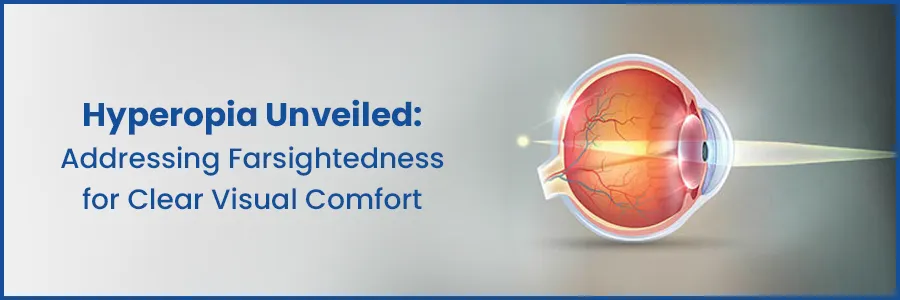Categories
- Cardiology 84
- Dermatology 45
- Endocrinology 33
- ENT 16
- Fertility 190
- Gastroenterology 78
- General-Medicine 81
- Gynecology 80
- Hematology 19
- Infectious-Diseases 33
- Neurology 52
- Oncology 34
- Ophthalmology 23
- Orthopedics 69
- Pediatrics 31
- Procedure 23
- Public-Health 144
- Pulmonology 59
- Radiology 8
- Urology 68
- Wellness 161
- Woman-and-child 77

Hyperopia Solutions for Clear Visual Comfort
Clear vision is a precious gift, allowing us to experience the world around us in all its vivid detail. However, for some, a common vision issue known as hyperopia, or farsightedness, can blur this visual experience.
In this blog, we'll delve into the intricacies of hyperopia, its meaning, symptoms, and available solutions, including LASIK surgery. So, let's unveil the world of hyperopia and explore how it can be addressed for optimal visual comfort.
Secure your health with a second opinion. Make informed decisions and book your appointment today!
Get A Second OpinionWhat is Hyperopia?
Hyperopia, often referred to as farsightedness or long-sightedness, is a refractive error of the eye. In simpler terms, it's a condition where distant objects can be seen more clearly than close objects. This occurs due to an eye shape that focuses light behind the retina instead of directly on it.
- Blurred Vision: Difficulty seeing nearby objects clearly.
- Symptoms: Eye fatigue, headaches, and a sense of unease.
By understanding these aspects, individuals can better recognise and manage hyperopia.
Types of Hypermetropia: Customizing Treatments to Individual Needs
Hyperopia isn't a one-size-fits-all condition. It's categorised into different types based on severity and associated factors, which helps eye care professionals tailor treatments accordingly:
- Simple Hypermetropia: The most common type, where faraway objects are seen clearly, but near objects appear blurry.
- Compound Hypermetropia: Both distant and close objects are blurry due to a steeper cornea or shorter eyeball.
- Mixed Hypermetropia: Often combined with astigmatism, causing uneven focusing that blurs vision at all distances.
Ready to take control of your health journey? Book your appointment now and start your path towards wellness today!
Book an AppointmentSymptoms of Long-Sightedness: Navigating Blurred Lines
Recognising the symptoms of hyperopia can empower individuals to seek timely treatment. Some common signs include:
- Blurry Vision Up Close: Reading a book or working on a computer might become challenging without squinting or holding the material farther away.
- Eye Strain and Discomfort: Activities that require prolonged close-up focus, such as writing or using a smartphone, can lead to eye fatigue, Headaches, and fatigue.
- Difficulty in Night Vision: Hyperopia might lead to problems in seeing clearly at night, particularly while driving.
- Eye Fatigue: Straining to compensate for farsightedness can tire the eyes quickly, leading to discomfort and aching.
- Squinting: People with hyperopia might unconsciously squint to bring objects into focus, which can further strain the eye muscles.
Exploring Solutions: LASIK Surgery for Farsightedness
Fortunately, there are various options to address hyperopia and restore clear vision. One of the most advanced solutions is LASIK (Laser-Assisted In Situ Keratomileusis) Surgery. LASIK has gained popularity as a safe and effective procedure for correcting a range of refractive errors, including hyperopia. In the process a precise laser restructures the cornea, enabling light to accurately converge on the retina. For hyperopia, the cornea is steepened to achieve the esired focal point, thereby improving near vision.
LASIK is known for its quick recovery time and minimal discomfort, making it a preferred choice for individuals seeking visual clarity without the dependence on glasses or contact lenses.
Expert Care for Hyperopia at Medicover Hospitals
In the realm of visual clarity and comfort, the skilled ophthalmologists at Medicover Hospitals are dedicated professionals. They specialise in understanding these conditions and offering personalised solutions, including advanced treatments like LASIK surgery.
With their expertise and commitment, our hyperopia doctors ensure each individual's journey towards optimal visual comfort is guided with care and supported by state-of-the-art technologies. At Medicover Hospitals, trust that your vision's future is in caring hands, where your well-being comes first.
Conclusion
Hyperopia, or Farsightedness, might initially blur the beauty of the world up close, but modern advancements in eye care have unveiled remarkable solutions. From understanding the nuances of hyperopia and its symptoms to exploring the transformative potential of LASIK surgery, the journey towards visual comfort is within reach. If you're experiencing symptoms of hyperopia, don't hesitate to consult an eye care professional who can guide you toward the best treatment for your unique needs.
Frequently Asked Questions
Hypermetropia, commonly known as farsightedness, is a refractive error where distant things can be seen more visible than near objects due to the eye focusing light behind the retina rather than directly on it.
Hypermetropia can be classified into different types based on severity: simple hypermetropia, compound hypermetropic astigmatism, and mixed hypermetropic astigmatism.
Compound hypermetropic astigmatism is a type of hypermetropia where there is both a hypermetropic (farsightedness) refractive error and astigmatism (irregular curvature of the cornea or lens).
Farsightedness, or hyperopia, is a condition where distant objects are seen more visible than near objects. It occurs when the eyeball is too short, or the cornea is too flat, causing light to focus behind the retina.
Hyperopia is a visual condition in which distant objects are clearer than near objects due to the eye focusing light behind the retina instead of on it. It is also known as hypermetropia or farsightedness.

Categories
- Cardiology 84
- Dermatology 45
- Endocrinology 33
- ENT 16
- Fertility 190
- Gastroenterology 78
- General-Medicine 81
- General 6
- Gynecology 80
- Hematology 19
- Infectious-Diseases 33
- Neurology 52
- Oncology 34
- Ophthalmology 23
- Orthopedics 69
- Pediatrics 31
- Procedure 23
- Public-Health 144
- Pulmonology 59
- Radiology 8
- Urology 68
- Wellness 161
- Woman-and-child 77